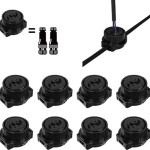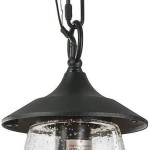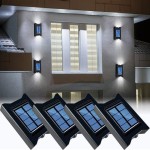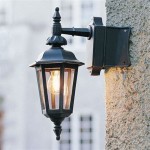Outdoor Lights with Wireless Switches: Convenience and Control
Outdoor lighting is an essential element for any home, providing security, ambiance, and functionality after dark. Traditional wired outdoor light fixtures often require complex installations and might not be easily accessible for switching. Wireless switches offer a convenient and flexible solution, allowing users to control their outdoor lights with ease. This article will explore the benefits, types, and considerations associated with outdoor lights equipped with wireless switches.
Benefits of Wireless Outdoor Lighting
Wireless outdoor lighting offers numerous advantages over traditional wired systems. Firstly, wireless switches eliminate the need for complicated wiring installations. This simplifies the setup process, allowing for quick and easy integration of lighting fixtures without the need for professional electricians. Secondly, wireless switches provide greater flexibility in terms of placement. They can be installed anywhere within range of the receiver, enabling users to control their lights from multiple locations. This is especially beneficial for large outdoor spaces or gardens where accessibility might be limited. Thirdly, wireless outdoor lighting offers enhanced convenience. Users can easily turn lights on or off from the comfort of their homes, balconies, or even remotely via smartphones or tablets. This eliminates the need to physically access the light fixture and offers greater control over the lighting environment.
Types of Wireless Switches for Outdoor Lighting
There are several types of wireless switches available for outdoor lighting, each with its own advantages and applications. The most common types include:
1. Radio Frequency (RF) Switches
RF switches utilize radio waves to transmit signals between the switch and the receiver. They are typically simpler to set up and offer longer range compared to other technologies. RF switches are often used for basic on/off control of outdoor lights. However, they may be susceptible to interference from other electronic devices.
2. Bluetooth Switches
Bluetooth switches use Bluetooth technology to communicate with the receiver. They offer a relatively short range but provide reliable connectivity. Bluetooth switches are typically used for controlling multiple lights individually or in groups. They may also offer features like dimming and scheduling capabilities.
3. Wi-Fi Switches
Wi-Fi switches connect to the internet, enabling users to control their lights remotely via smartphones, tablets, or voice assistants. They offer the widest range of features and the ability to integrate with smart home systems. However, Wi-Fi switches require a stable internet connection and may be more expensive than other types.
Considerations for Choosing Wireless Outdoor Lights
When choosing wireless outdoor lights, several factors should be considered:
1. Range and Coverage
The range of the wireless signal is crucial for determining the effectiveness of the system. Ensure that the selected switches and lights provide sufficient coverage for the intended application. Consider the size of the outdoor space and any potential obstacles that might interfere with the signal.
2. Battery Life and Power Source
Most wireless switches require batteries or external power sources. Choose options with long battery life or convenient charging methods. For lights with built-in wireless switches, consider the power source and its compatibility with outdoor conditions.
3. Features and Functionality
Different wireless switches offer varying levels of functionality. While some provide basic on/off control, others include dimming, scheduling, and integration with smart home systems. Choose options that meet your specific needs and preferences. For example, if you require the ability to control multiple lights independently, ensure that the chosen system supports group control.
4. Security and Privacy
Consider the security implications of wireless switches, especially for outdoor lights that may be exposed to potential vulnerabilities. Choose options with secure protocols and robust encryption to protect your data and network from unauthorized access. Ensure that the system uses a secure password or authentication mechanisms.
In conclusion, wireless switches offer a compelling solution for outdoor lighting, providing convenience, flexibility, and greater control over the lighting environment. By carefully considering the different types of wireless switches, their features, and the relevant considerations, users can choose the perfect system for their specific needs and preferences. The benefits of wireless outdoor lighting can enhance the functionality, security, and aesthetics of any outdoor space.

Led Outdoor On Off Power Switch With Wireless Remote Step 1 Dezigns

Greencycle Wireless Light Switch And Receiver Kit Outdoor 1900 Ft Indoors 229 Remote Control Ceiling Lamp Led Bulb Ip54 Waterproof 1 Swicth Reciver Com

Szrsth Solar Lights Outdoor Waterproof Motion Sensor Security With Wireless Remote Control 2500lm 3heads 210led Flood For Patio Garage Yard Entryways Com

The 3 Best Smart Outdoor Lights For Backyards Of 2024 Reviews By Wirecutter

Greencycle Wireless Light Switch And Receiver Kit Outdoor 1900 Ft Indoors 229 Remote Control Ceiling Lamp Led Bulb Ip54 Waterproof 1 Swicth Reciver Com

Outdoor And Backyard Lighting We Love Reviews By Wirecutter

Ring Lighting Indoor Outdoor Home Switches And Bulbs

7 Ways To Power Outdoor Lights Without Electricity

Waterproof Outdoor Led Light Wireless Remote Control Power Switch Plug In

Link2home 15 Amp Wireless Outdoor Remote Control Switch 1 Rcv With 2 Grounded S And Black Em Or650b The Home Depot
Related Posts







